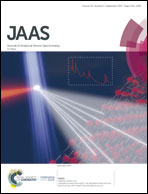Investigation of the intensity dependence of glow discharge mass spectrometry quantification on the discharge parameters†
Abstract
In direct current-glow discharge mass spectrometry (dc-GDMS), the current, voltage and argon pressure can be selected with two degrees of freedom to define the analytical conditions. The Astrum GD-MS allows control of the current or voltage up to 8 mA and 2000 V, respectively. It is crucial to study if and how variation in the operating parameters (current, voltage and Ar pressure) can effect the quantification of impurities. To study these effects, a tantalum pin (>99.9%) sample was analyzed from 0.5 mA to 5 mA at 1000 V and from 600 V to 1500 V at 3 mA. The results of the study indicate that the calculated concentrations of impurities vary differently as a function of changes in the operating parameters. Some elements are more sensitive to changes in the operating parameters than other elements. The variation in the quantification of impurities is associated with differences in the dependencies of the ion intensities of the trace and matrix elements under the discharge conditions. The difference in the relative sensitivity factors (RSFs) at different discharge settings can thus be attributed to these findings.



 Please wait while we load your content...
Please wait while we load your content...